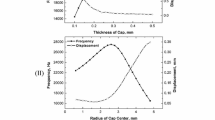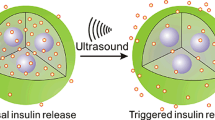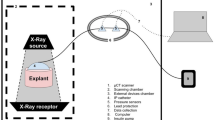Abstract
Purpose
In previous studies, ultrasound mediated transdermal drug delivery has shown a promising potential as a method for noninvasive drug administration. For prospective future human application, this study was designed to determine the feasibility of lightweight cymbal transducer array as a practical device for noninvasive transdermal insulin delivery in large pigs.
Materials and Methods
Six Yorkshire pigs (100–140 lbs) were divided into two groups. As the control (n = 3), the first group did not receive any ultrasound exposure with the insulin. The second group (n = 3) was treated with ultrasound and insulin at 20 kHz with an Isptp = 100 mW/cm2 at a 20% duty cycle for 60 min. With the pigs in lateral recumbency after anesthesia, the ultrasound transducer with insulin was placed on the axillary area of the pig. At the beginning and every 15 min up to 90 min, the blood glucose level was determined using a glucose monitoring system. To compare the results of individual animals, the change of blood glucose level was normalized to each animal’s initial glucose value at the start of the experiment.
Results
Although each animal had a different initial glucose level, the mean and standard error for the six animals was 146 ± 13 mg/dl. For the control group, the blood glucose level increased to 31 ± 21 mg/dl compared to the initial baseline over the 90 min experiment. However for the ultrasound with insulin treated group, the glucose level decreased to −72 ± 5 mg/dl at 60 min (p < 0.05) and continued to decrease to −91 ± 23 mg/dl in 90 min (p < 0.05).
Conclusion
The results indicate the feasibility of ultrasound mediated transdermal insulin delivery using the cymbal transducer array in animal with a similar size and weight to a human. Based on these result, the cymbal array has potential as a practical ultrasound system for noninvasive transdermal insulin delivery for diabetes management.



Similar content being viewed by others
References
M. R. Prausnitz. Reversible skin permeabilization for transdermal delivery of macromolecules. Crit. Rev. Ther. Drug Carrier Syst. 14:455–483 (1997).
M. R. Prausnitz. A practical assessment of transdermal drug delivery by skin electroporation. Adv. Drug Deliv. Rev. 35:61–76 (1999).
F. Montorsi, A. Salonia, G. Guazzoni, L. Barbieri, R. Colombo, M. Brausi, V. Scattoni, P. Rigatti, and G. Pizzini. Transdermal electromotive multi-drug administration for Peyronie’s disease: preliminary results. J. Androl. 21:85–90 (2000).
Y. Wang, R. Thakur, Q. Fan, and B. Michniak. Transdermal iontophoresis: combination strategies to improve transdermal iontophoretic drug delivery. Eur. J. Pharm. Biopharm. 60:179–191 (2005).
A. Nanda, S. Nanda, and N. M. Ghilzai. Current developments using emerging transdermal technologies in physical enhancement methods. Curr. Drug Deliv. 3:233–242 (2006).
J. Kost. Ultrasound-assisted insulin delivery and noninvasive glucose sensing. Diabetes Technol. Ther. 4:489–497 (2002).
M. J. King, I. Badea, J. Solomon, P. Kumar, K. J. Gaspar, and M. Foldvari. Transdermal delivery of insulin from a novel biphasic lipid system in diabetic rats. Diabetes Technol. Ther. 4:479–488 (2002).
K. Tachibana and S. Tachibana. The use of ultrasound for drug delivery. Echocardiography 18:323–328 (2001).
W. G. Pitt, G. A. Husseini, and B. J. Staples. Ultrasonic drug delivery—a general review. Expert Opin Drug Deliv. 1:37–56 (2004).
S. Mitragotri. Healing sound: the use of ultrasound in drug delivery and other therapeutic applications. Nat. Rev. Drug Discov. 4:255–260 (2005).
S. Mitragotri, D. A. Edwards, D. Blankschtein, and R. Langer. A mechanistic study of ultrasonically-enhanced transdermal drug delivery. J. Pharm. Sci. 84:697–706 (1995).
S. Mitragotri, D. Blankschtein, and R. Langer. An explanation for the variation of the sonophoretic transdermal transport enhancement from drug to drug. J. Pharm. Sci. 86:1190–1192 (1997).
H. R. Guzman, A. J. McNamara, D. X. Nguyen, and M. R. Prausnitz. Bioeffects caused by changes in acoustic cavitation bubble density and cell concentration: a unified explanation based on cell-to-bubble ratio and blast radius. Ultrasound Med. Biol. 29:1211–1222 (2003).
R. K. Schlicher, H. Radhakrishna, T. P. Tolentino, R. P. Apkarian, V. Zarnitsyn, and M. R. Prausnitz. Mechanism of intracellular delivery by acoustic cavitation. Ultrasound Med. Biol. 32:915–924 (2006).
N. B. Smith. Perspectives on transdermal ultrasound mediated drug delivery. International Journal of Nanomedicine 2(2). (2007). (in press).
Congressionally established diabetes research working group. Conquering diabetes: a strategic plan for the 21th century. NIH Publication No. 99-4398. 1999.
The Whitaker Foundation. Biomedical engineering and the fight against diabetes, 2003 Annual Report. The Whitaker Foundation, Arlington, VA, 2004.
K. Tachibana. Transdermal delivery of insulin to alloxan-diabetic rabbits by ultrasound exposure. Pharm. Res. 9:952–954 (1992).
S. Mitragotri, D. Blankschtein, and R. Langer. Ultrasound-mediated transdermal protein delivery. Science 269:850–853 (1995).
I. Zhang, K. K. Shung, and D. A. Edwards. Hydrogels with enhanced mass transfer for transdermal drug delivery. J. Pharm. Sci. 85:1312–1316 (1996).
A. Boucaud, L. Tessier, L. Machet, L. Vaillant, and F. Patat. Transdermal delivery of insulin using low frequency ultrasound. In Proceedings of the IEEE 2000 Ultrasonics Symposium, San Juan Porto Rico, 2000, pp. 1453–1456.
A. Boucaud, M. A. Garrigue, L. Machet, L. Vaillant, and F. Patat. Effect of sonication parameters on transdermal delivery of insulin to hairless rats. J. Control. Release 81:113–119 (2002).
N. B. Smith, S. Lee, E. Maione, R. B. Roy, S. McElligott, and K. K. Shung. Ultrasound mediated transdermal transport of insulin through in vitro human skin using novel transducer designs. Ultrasound Med. Biol. 29:311–317 (2003).
K. Tachibana and S. Tachibana. Transdermal delivery of insulin by ultrasonic vibration. J. Pharm. Pharmacol. 43:270–271 (1991).
D. Stansfield. Underwater electroacoustic transducers. Bath University Press, Bath, UK, 1990.
O. B. Wilson. An introduction to the theory and design of sonar transducers. Peninsula, Los Altos, CA, 1988.
K. K. Shung, M. B. Smith, and B. Tsui. Principles of medical imaging. Academic, San Diego, 1992.
R. E. Newnham, Q. C. Xu, and S. Yoshikawa. Transformed stress direction acoustic transducer. US Patent 4,999,819, March 12, 1991.
R. E. Newnham, Q. C. Xu, and S. Yoshikawa. Metal-electroactive ceramic composite actuators. US Patent 5,276,657, January 4, 1994.
E. Maione, K. K. Shung, R. J. Meyer, J. W. Hughes, R. E. Newnham, and N. B. Smith. Transducer design for a portable ultrasound enhanced transdermal drug delivery system. IEEE Trans. Ultrason. Ferroelectr. Freq. Contr. 49:1430–1436 (2002).
N. B. Smith, S. Lee, and K. K. Shung. Ultrasound-mediated transdermal in vivo transport of insulin with low-profile cymbal arrays. Ultrasound Med. Biol. 29:1205–1210 (2003).
S. Lee, R. E. Newnham, and N. B. Smith. Short ultrasound exposure times for noninvasive insulin delivery in rats using the light weight cymbal array. IEEE Trans. Ultrason. Ferroelectr. Freq. Contr. 51:176–180 (2004).
S. Lee, B. Snyder, R. E. Newnham, and N. B. Smith. Noninvasive ultrasonic transdermal insulin delivery in rabbits using the light-weight cymbal array. Diabetes Technol. Ther. 6:808–815 (2004).
B. Snyder, S. Lee, R. E. Newnham, and N. B. Smith. Ferroelectric transducer arrays for transdermal insulin delivery. J. Mater. Sci. 41:211–216 (2006).
S. Lee, V. Nayak, J. Dodds, M. Pishko, N. B. Smith. Ultrasonic mediated glucose measurements in vivo using the cymbal array. Ultrasound Med. Biol. 31:971–977 (2005).
R. J. Meyer, A. Dogan, C. Yoon, S. M. Pilgrim, and R. E. Newnham. Displacement amplification of electroactive materials using the cymbal flextensional transducer. Sens. Actuators 87:157–162 (2001).
IEEE. IEEE guide for medical ultrasound field parameter measurements. Institute of Electrical and Electronics Engineers, Inc., New York, 1990.
AIUM. Acoustic output labeling standard for diagnostic ultrasound equipment. American Institute of Ultrasound in Medicine, Laurel, MD, 1998.
W. G. Pond and K. A. Houpt. The biology of the pig. Cornell University Press, Ithaca, NY, 1978.
D. Danfaer. A quantitative biology of the pig. CABI, New York, NY, 1998.
J. F. Tressler, W. Cao, K. Uchino, and R. E. Newnham. Finite element analysis of the cymbal-type flextensional transducer. IEEE Trans. Ultrason., Ferroelect. Freq. Contr. 45:1363–1369 (1998).
J. E. Harkness and D. J. Wagner. The biology and medicine of rabbits and rodents. Williams and Willkins, Baltimore MD, 1995.
M. Pavlovic, K. Wroblewski, Y. Manevich, S. Kim, and J. E. Biaglow. The importance of choice of anaesthetics in studying radiation effects in the 9L rat glioma. Br. J. Cancer., Suppl. 27:S222–S225 (1996).
E. Hillyer and K. E. Quesenberry. Ferrets, rabbits, and rodents: clinical medicine and surgery. Saunders, Philadelphia PA, 1997.
N. Kawai, R. F. Keep, and A. L. Betz. Hyperglycemia and the vascular effects of cerebral ischemia. Stroke. 28:149–154 (1997).
K. E. Heim, J. S. Morrell, A. M. Ronan, and A. R. Tagliaferro. Effects of ketamine-xylazine and isoflurane on insulin sensitivity in dehydroepiandrosterone sulfate-treated minipigs (Sus scrofa domestica). Comp. Med. 52:233–237 (2002).
H. Rifkin and D. Porte. Ellenberg and rifkin’s diabetes. Elsevier, New York, NY, 1990.
J. E. Shaw, P. Z. Zimmet, de Court, G. K. Dowse, P. Chitson, H. Gareeboo, F. Hemraj, D. Fareed, J. Tuomilehto, and K. G. Alberti. Impaired fasting glucose or impaired glucose tolerance. What best predicts future diabetes in Mauritius? Diabetes Care. 22:399–402 (1999).
G. P. Carnevale Schianca, A. Rossi, P. P. Sainaghi, E. Maduli, and E. Bartoli. The significance of impaired fasting glucose versus impaired glucose tolerance: importance of insulin secretion and resistance. Diabetes Care. 26:1333–1337 (2003).
Acknowledgements
This work was supported by the Department of Defense Technologies for Metabolic Monitoring Award Number W81XWH-05-1-0617.
Author information
Authors and Affiliations
Corresponding author
Rights and permissions
About this article
Cite this article
Park, E.J., Werner, J. & Smith, N.B. Ultrasound Mediated Transdermal Insulin Delivery in Pigs Using a Lightweight Transducer. Pharm Res 24, 1396–1401 (2007). https://doi.org/10.1007/s11095-007-9306-4
Received:
Accepted:
Published:
Issue Date:
DOI: https://doi.org/10.1007/s11095-007-9306-4




